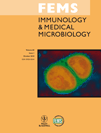A role for CXC chemokine receptor-2 in the pathogenesis of urogenital Chlamydia muridarum infection in mice
Editor: Peter Timms
Present addresses: Shanon R. Lacy, Department of Pathology and Laboratory Medicine, Van Nuys Medical Science Building, Room 128, Indiana University School of Medicine, 635 Barnhill Drive, Indianapolis, IN 46202-5120, USACandace M. Murray, Dwight D. Eisenhower Army Medical Center, 300 E. Hospital Rd, Fort Gordon, GA 30905, USA.
Abstract
We tested the hypothesis that a specific chemokine receptor, CXC chemokine receptor-2 (CXCR2), mediates acute inflammatory damage during chlamydial urogenital infection, which ultimately leads to the chronic sequelae of hydrosalpinx – a surrogate marker of infertility. Homozygous CXCR2 genetic knockouts (CXCR2−/−), heterozygous littermates (CXCR2+/−) or homozygous wild-type (wt) controls (CXCR2+/+) were infected intravaginally with Chlamydia muridarum. Although no change was observed in the infection in the lower genital tract based on CXCR zygosity, a delay in the ascension of infection into the upper genital tract was seen in CXCR2−/− mice. Significantly elevated peripheral blood neutrophil counts were observed in CXCR2−/− mice when compared with controls. Reduced rates of acute inflammatory indices were observed in the affected tissue, indicating reduced neutrophil extravasation capacity in the absence of CXCR2. Of note was a reduction in the postinfection development of hydrosalpinx that correlated with CXCR2 zygosity, with both CXCR2−/− (13%) and their CXCR2+/− (35%) littermates displaying significantly lower rates of hydrosalpinx formation than the wt CXCR2-sufficient mice (93%). We conclude that CXCR2 ligands are a major chemotactic signal that induces damaging acute inflammation and the resulting chronic pathology during the repair phase of the host response, but are dispensable for the resolution of infection.




